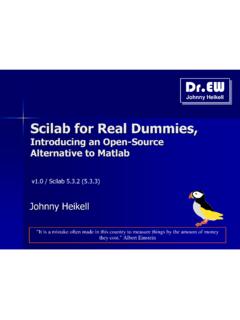Transcription of MODELING IN XCOS USING MODELICA - Openeering
1 Poweredby MODELING IN xcos USING MODELICA In this tutorial we show how to model a physical system described by ODE USING the MODELICA extensions of the xcos environment. The same model has been solved also with Scilab and xcos in two previous tutorials. Level This work is licensed under a Creative Commons Attribution-NonCommercial-NoDerivs Unported License. Tutorial xcos + MODELICA page 2/19 Step 1: The purpose of this tutorial Scilab provides three different approaches (see figure) for MODELING a physical system described by Ordinary Differential Equations (ODE). For showing all these capabilities we selected a common physical system, the LHY model for drug abuse.
2 This model is used in our tutorials as a common problem to show the main features for each strategy. We are going to recurrently refer to this problem to allow the reader to better focus on the Scilab approach rather than on mathematical details. In this third tutorial we show, step by step, how the LHY model problem can be implemented in the xcos + MODELICA environment. The sample code can be downloaded from the Openeering web site. 1 Standard Scilab Programming 2 xcos Programming 3 xcos + MODELICA Step 2: Model description The considered model is the LHY model used in the study of drug abuse. This model is a continuous-time dynamical system of drug demand for two different classes of users: light users (denoted by ) and heavy users (denoted by ) which are functions of time.
3 There is another state in the model that represents the decaying memory of heavy users in the years (denoted by ) that acts as a deterrent for new light users. In other words the increase of the deterrent power of memory of drug abuse reduces the contagious aspect of initiation. This approach presents a positive feedback which corresponds to the fact that light users promote initiation of new users and, moreover, it presents a negative feedback which corresponds to the fact that heavy users have a negative impact on initiation. Light users become heavy users at the rate of escalation and leave this state at the rate of desistance . The heavy users leave this state at the rate of desistance.
4 Tutorial xcos + MODELICA page 3/19 Step 3: Mathematical model The mathematical model is a system of ODE (Ordinary Differential Equation) in the unknowns: , number of light users; , number of heavy users; , decaying of heavy user years. The initiation function contains a spontaneous initiation and a memory effect modeled with a negative exponential as a function of the memory of year of drug abuse relative to the number of current light users. The problem is completed with the specification of the initial conditions at the time . The LHY equations system (omitting time variable for sake of simplicity) is { where the initiation function is { } The LHY initial conditions are { Tutorial xcos + MODELICA page 4/19 Step 4: Problem data (Model data) : the annual rate at which light users quit : the annual rate at which light users escalate to heavy use : the annual rate at which heavy users quit : the forgetting rate (Initiation function) : the number of innovators per year : the annual rate at which light users attract non-users : the constant which measures the deterrent effect of heavy use.}}
5 The maximum rate of generation for initiation (Initial conditions) : the initial simulation time; : Light users at the initial time; : Heavy users at the initial time; : Decaying heavy users at the initial time. Model data Initiation function Initial conditions Tutorial xcos + MODELICA page 5/19 Step 5: xcos + MODELICA programming introduction MODELICA is a component-oriented declarative language useful for MODELING the behavior of physical systems, consisting of electrical, hydraulic, mechanical and other domains. MODELICA language is useful for exchanging mathematical models since it provides a way to describe model components and their structure in libraries.
6 The description of the these models is done USING a declarative language based on equations, in contrast to usual programming that is based on the use of assignment statements. This permits a great flexibility and enhance reading scheme since equations have no pre-defined causality, equations do not have a pre-defined input/output relation, models are acausal models. MODELICA blocks are identical to standard xcos blocks except for the fact that are of implicit type. Blocks with implicit dynamic ports mean that the connections between two or more ports do not impose any transfer of information in a known direction. These blocks are denoted by a black square and the user can connect implicit blocks of the same domain.
7 MODELICA blocks in xcos require a C compiler since MODELICA translates the system directly into a C file that is then linked to the xcos environment. To check if a compiler is available in your Scilab environment use command haveacompiler . For information about supported and compatible compilers see Scilab documentation. In the figure we show the available blocks for the Electrical palette. Tutorial xcos + MODELICA page 6/19 Step 6: Across and Through An import concept to understand how MODELICA block work is the difference between across and through variables: Across : A variable whose value is determined by the measure with an instrument in parallel; ( voltage for the electrical domain) Through : A variable whose value is determined by the measure with an instrument in series.
8 ( current for the electrical domain) Typically, the product of an across variable with a through variable is the power exchanged by the element. Step 7: Roadmap In this tutorial we describe how to construct the LHY model and how to simulate it in xcos + MODELICA . We implement the system in the following way: First we provide a comparative example (RLC circuit) between xcos and MODELICA ; A general description of the MODELICA Blocks available in xcos is given; Then we implement the LHY model in xcos + MODELICA ; In the end, we test the program and visualize the results. Descriptions Steps RLC example 8-11 xcos MBLOCK 12-16 LHY example 17-20 Test and visualize 21 Tutorial xcos + MODELICA page 7/19 Step 8: RLC Example A comparative example, based on a RLC electric circuit, is use to show the differences between a pure xcos diagram and an xcos + MODELICA scheme.
9 The adopted scheme, reported on the right, is composed of the following components: Voltage source (Amplitude A = [V], Frequency f = 1 [Hz]); with equation: ; Resistor (Resistance R = [Ohm]) with equation: ; Inductor (Inductance L = [H], Initial current = 0) with equation: Capacitor (Capacitance C = [F], Initial voltage = 0) with equation: where we are interested in measuring the voltage across the capacitor and the current through the voltage source. Tutorial xcos + MODELICA page 8/19 Step 9: RLC Analytical solution If we write the equation for the 8 unknowns variables , , and we have: (2 equations) (Kirchhoff s current law) (2 equations) (Kirchhoff s voltage law) (4 equations) (Constitutive equations) which have the following analytical solution: The analytical solution is plotted on the right: and.
10 Analytical solution: ( ) Tutorial xcos + MODELICA page 9/19 Step 10: RLC xcos model1 There are many xcos blocks formulation for the RLC circuit but one which allows fast and accurate results is the one that uses only integration blocks instead of derivate blocks. Hence, the idea is to start from the equality and make the following part of the scheme: The next step is to add sum blocks that represent the local conversion of Kirchhoff s laws: and to add the model of as follows: 1 See Introduction to Control Systems in Scilab , Scilab Tutorials, Openeering , 2012 Tutorial xcos + MODELICA page 10/19 Step 11: RLC with xcos + MODELICA Here, we use elements available in the Electrical Palette to make the system.








